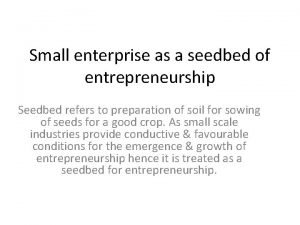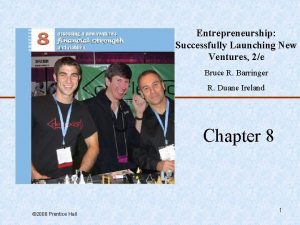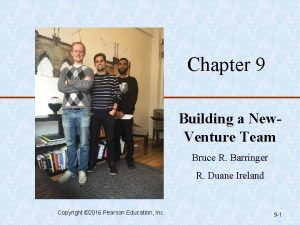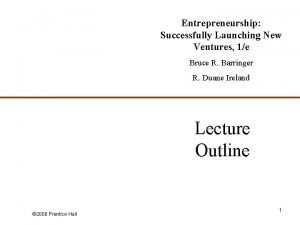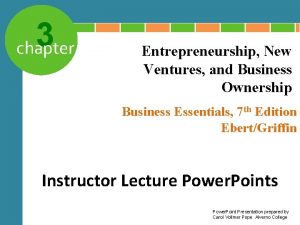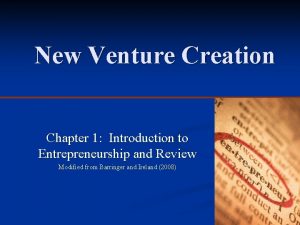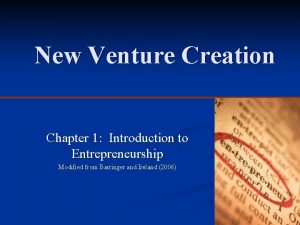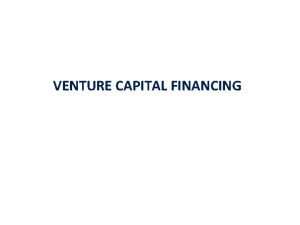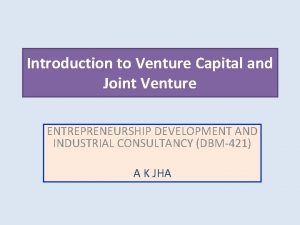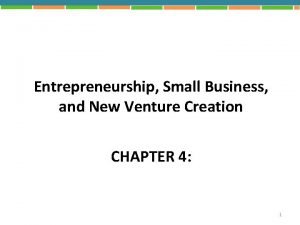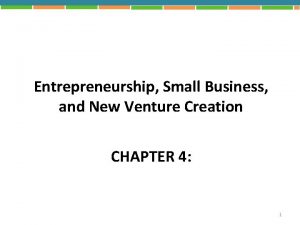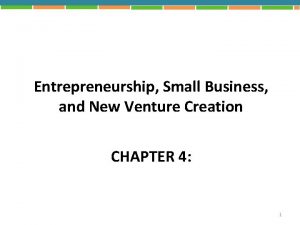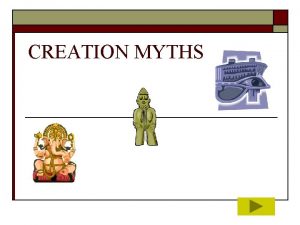New Venture Creation Chapter 1 Introduction to Entrepreneurship















- Slides: 15

New Venture Creation Chapter 1: Introduction to Entrepreneurship Modified from Barringer and Ireland (2006)

Introduction to Entrepreneurship n Very exciting time to study entrepreneurship n GEM Studies n n n Business School Education n n 2003: 300 million people, 12. 5% adults in 40 countries involved in forming new businesses 2005: USA early-stage entrepreneurial activity more than twice the rate of other countries (in 2005, 12. 4% US population engaged in entrepreneurship) To help spur economic activity, many firms providing funding to entrepreneurship programs across the USA Governmental & Community Resources for Entrepreneurs n SBAs: http: //www. sba. gov/ n SBIRs: http: //www. sba. gov/SBIR/ n SBDCs: http: //www. odod. state. oh. us/edd/osb/sbdc/default. htm n Business Incubators: http: //www. techincubator. org/

What is Entrepreneurship? n Entrepreneurship Defined n The process by which individuals pursue opportunities without regard to the resources they currently control with the ultimate goal of creating new “value” n Involves identifying opportunities, putting useful ideas into practice n Tasks require creativity, drive, and a willingness to take risks n n Ex: e. Bay’s Pierre Omidyar and Microsoft’s Bill Gates Inventor ≠ Entrepreneur n An inventor creates something new n Entrepreneurs put the resources together to commercialize inventions n Entrepreneurs assemble resources (e. g. , money, people, strategy, and risk bearing ability) to transform inventions into viable businesses n Entrepreneurship requires a different set of skills that can be learned and honed n That’s why we’re here!!!

Another Type of Entrepreneurship n Corporate Entrepreneurship n Is entrepreneurship at the firm level n Involves an existing firm acting entrepreneurially n n Successful examples: Apple, Virgin Group, Darden n Unsuccessful examples: Delta’s Song, Continental Lite To determine firms’ entrepreneurial orientations, imagine a conceptual continuum ranging from highly conservative to highly entrepreneurial n The position of a firm on this continuum is its entrepreneurial intensity n Highly entrepreneurially intense firms are proactive, innovative, and risk taking n Conservative firms take a more “wait and see” posture, are less innovative, and are risk adverse

What Motivates People to Become Entrepreneurs? n 3 primary reasons n Desire to be their own boss Most common reason n Due to frustration with traditional jobs n When this is the only reason, firms are usually small-tomedium sized at full growth n n Desire to pursue their own ideas Passion to see ideas realized n Identify a problem and a solution to that problem n Many established firms resist change n n Financial rewards Secondary concern n GEM study: In 1997, only 13. 3% of owners of SMEs in the US made more than $50, 000/year n

4 Main Characteristics of Successful Entrepreneurs 1. Passion for the Business • • • 2. #1 characteristic shared by successful entrepreneurs Stems from beliefs that firm positive effect on society Caution: Don’t wear “rose-colored glasses” Product/Customer Focus • • Keeping a focus on the products and customers needs/requirements is very important Main point: successful entrepreneurs introduce products/services that fulfill needs versus introducing them for the sake of introducing them n Ex: Apple’s Steve Jobs vs. Infomercials (e. g. , i. Pod Flea)

4 Main Characteristics of Successful Entrepreneurs 3. Tenacity Despite Failure • • 4. Because entrepreneurs generally try new things, failure rate is naturally high The ability to persevere through setbacks is key Execution Intelligence • Involves the ability to translate thought, creativity, and imagination into action and measurable results n n Successful examples: Starbucks, Wal-Mart Problematic examples: The Singing Machine, Delta’s Song

Misconceptions of Entrepreneurs and Theory n Neoclassical school (Kirzner, 1973) n n Fundamental attributes of people determine if they become entrepreneurs Psychological school (cf. Covin & Slevin, 1989; Shave & Scott, 1991) n n In addition to fundamental attributes, people must have ability and initiative Austrian Economics school (Hayek, 1945; Shane, 2000) n n Not everyone can be an entrepreneur The possession of certain information determines who becomes an entrepreneur

5 Common Myths about Entrepreneurs 1. Entrepreneurs are Born not Made • 2. Entrepreneurs are not genetically predisposed but there are common characteristics of successful entrepreneurs and these can be developed via one’s social context (on next slide) Entrepreneurs are Gamblers • Actually entrepreneurs are moderate risk takers 3. Entrepreneurs are Motivated Primarily by Money 4. Entrepreneurs should be Young and Energetic 5. • Average is 35 -45 with 10+ years of work experience • Investors look at experience, maturity, reputation, and track record Entrepreneurs Love the Spotlight • Often their work involves proprietary products/services

Other Characteristics of Successful Entrepreneurs n n n n n Achievement motivated Alert to opportunities Creative Decisive Energetic Internal locus of control Moderate risk taker High need to achieve Is a networker n n n n n Persuasive Promoter Resource assembler/ leverager Self-confident Self-starter Strong work ethic Tenacious Tolerant of ambiguity Visionary • Research suggests that people with entrepreneur parents are more likely to become entrepreneurs and people who know an entrepreneur are > twice as likely to start a business versus those who do not. • The lesson: a person’s social context helps to shape these characteristics

Types of New Ventures n n n Lifestyle or part-time firms (e. g. , lifestyle firms, micro-businesses): n Usually pursued part-time and only until “something better comes along” n Sometimes allows founder(s) to pursue a special interest or hobby Traditional small businesses (e. g. , SMEs, salary-substitutes businesses): n Allow founders to earn a salary similar to a traditional job n No high growth aspirations and usually one office location n Original founder(s) maintain control over the firm n Plan to operate the firm indefinitely High-growth ventures: n Founder(s) intend to grow the firm in scale (multiple sites) n Target markets are generally at the national or international level n Founders usually do not maintain control over the firm indefinitely and hand it over to more qualified individuals when it grows to a certain level

Why Entrepreneurship is Important: Creative Destruction n Creative Destruction occurs when new and/or improved products replace existing ones, which impacts consumer demand stimulates economic activity n First discussed by Joseph Schumpeter in 1934 Theory of Economic Development n n Argued the new products and technologies make other obsolete through creative destruction Start-up ventures initiate creative destruction as they are “innovators” or “agents of change”

Why Entrepreneurship is Important: Economic Impact on Society n Innovation n The process of creating something new, is central to the entrepreneurial process n Small firms responsible for over 2/3 all innovations in U. S. n n n Ex: Nistevo trucking; Southwest; e. Bay Job Creation n 1970: Fortune 500 employed 20% US labor force n 1996: Fortune 500 employed 8. 5% US labor force n Between 1993 -1996, new high-growth firms created 2/3 of new job in US Globalization n 2006, 97% of U. S. exporters are small businesses with < 500 employees n 2005 GEM report shows trend for entrepreneurship across the US and world is increasing

Why Entrepreneurship is Important: Impact on Society and Larger Firms n Impact on Society n Innovations of entrepreneurial firms have a dramatic impact on society n Think of new products and services that make our lives easier, more productive, healthier, and more entertained n n PCs, Internet, digital media, George Foreman grill (“Knock the Fat Out!) Impact on Larger Firms n Many firms build their entire business models around helping larger firms become more efficient and effective n Examples: Small biotech firms; shipping companies (e. g. , Fed. Ex); HRM companies n Porter’s Value Chain will help us to identify business models that fill this need (we’ll discuss this later in the semester)

The Entrepreneurial Process n n The Entrepreneurial Process Consists of Four Steps n Step 1: Deciding to become an entrepreneur n Step 2: Developing successful business ideas n Step 3: Moving from an idea to an entrepreneurial firm n Step 4: Managing and growing the entrepreneurial firm Throughout the semester, we will cover these steps
 Entrepreneurship module 1 introduction to entrepreneurship
Entrepreneurship module 1 introduction to entrepreneurship Small business is a seedbed of entrepreneurship
Small business is a seedbed of entrepreneurship Contoh proses perencanaan sdm
Contoh proses perencanaan sdm Parts of dehydrated business plan
Parts of dehydrated business plan New venture fitness drinks
New venture fitness drinks New venture team
New venture team Assessing a new venture's financial strength and viability
Assessing a new venture's financial strength and viability New venture fitness drinks concept statement
New venture fitness drinks concept statement Chapter 3 feasibility analysis
Chapter 3 feasibility analysis What is entrepreneurship
What is entrepreneurship Aldersgate united methodist church
Aldersgate united methodist church Types of secondary brand associations
Types of secondary brand associations New creation theology
New creation theology Entrepreneurship: successfully launching new ventures
Entrepreneurship: successfully launching new ventures Generation of a new entry opportunity
Generation of a new entry opportunity Entrepreneurship new ventures and business ownership
Entrepreneurship new ventures and business ownership

